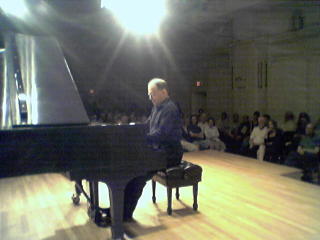 Marc-André Hamelin, appearing at the Mannes College of Music as part of the International Keyboard Institute and Festival played Schubert's A major sonata, D664, out on its lightest, gentlest side. It was treatment that the work can not only withstand but one that, in the right hands, becomes it. (This in contrast to the Mozart that Ionarts thought too 'Dresden china-y' when we last heard him at the National Gallery.) Given Mr. Hamelin's famous technical faculties, I am convinced that his neurons don't even bother firing up certain parts of his brain until he starts playing Godowsky or Liszt... both of which, conincidentally, were served up after the Schubert. The A major sonata meanwhile did not suffer from his excess skill, though the outer movements (Allegro moderato and Allegro) were more convincing than a slightly angular Andante.
Marc-André Hamelin, appearing at the Mannes College of Music as part of the International Keyboard Institute and Festival played Schubert's A major sonata, D664, out on its lightest, gentlest side. It was treatment that the work can not only withstand but one that, in the right hands, becomes it. (This in contrast to the Mozart that Ionarts thought too 'Dresden china-y' when we last heard him at the National Gallery.) Given Mr. Hamelin's famous technical faculties, I am convinced that his neurons don't even bother firing up certain parts of his brain until he starts playing Godowsky or Liszt... both of which, conincidentally, were served up after the Schubert. The A major sonata meanwhile did not suffer from his excess skill, though the outer movements (Allegro moderato and Allegro) were more convincing than a slightly angular Andante. L. Godowsky, Complete Studies on Chopin's Etudes, M.-A. Hamelin Hyperion     |
 F. Liszt, Liszt at the Opera, Leslie Howard Hyperion     |
Anyone, meanwhile, who saw the jam-packed Mannes College concert hall with an audience of an average age of near or even below 30 might hesitate to spell out doom for the future of American classical music concert audiences. By the time all the piano connoisseur-tweens have reached their 40s, they'll have spread the passion manifold among acquaintances, friends, and lovers. They also got a few encores on the way, including a Chopin/Liszt Polish Song, a work titled "Anamorphosis" by Salvatore Sciarr(in)o that was a hilarious and self-deprecating study (part Ravel, part "Singing in the Rain"), and Antheil's riotous and painfully funny Jazz Sonata - one of the "most perfect musical crimes ever committed" according to Mr. Hamelin.

No comments:
Post a Comment